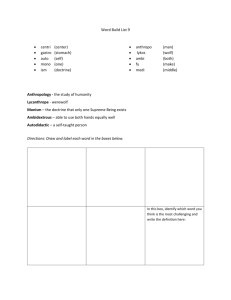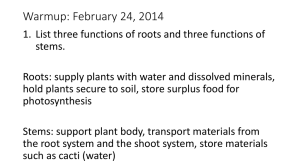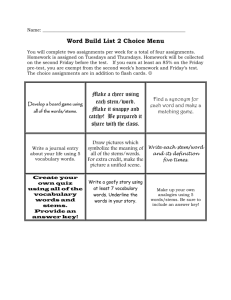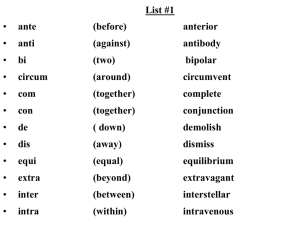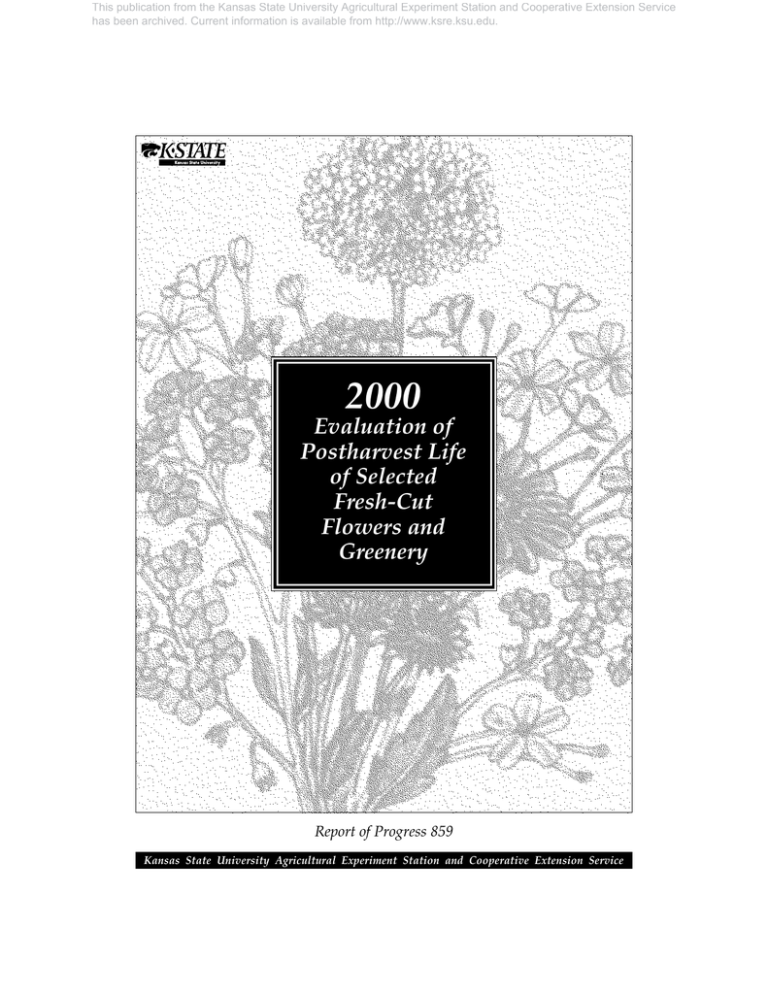
This publication from the Kansas State University Agricultural Experiment Station and Cooperative Extension Service
has been archived. Current information is available from http://www.ksre.ksu.edu.
2000
Evaluation of
Postharvest Life
of Selected
Fresh-Cut
Flowers and
Greenery
Report of Progress 859
Kansas State University Agricultural Experiment Station and Cooperative Extension Service
This publication from the Kansas State University Agricultural Experiment Station and Cooperative Extension Service
has been archived. Current information is available from http://www.ksre.ksu.edu.
2000 Evaluation of Postharvest Life
of Selected Fresh-Cut Flowers and Greenery
Karen L.B. Gast, Ph.D.
Department of Horticulture, Forestry and Recreation Resources
Kansas State University
Rebecca J. Inch
Plant Science Department
Lincoln University, New Zealand
Fresh-cut, hand-tied bouquets are popular items at farmers’ markets and also at florist shops. Attractive bouquets include
flowers that provide specific design elements. These include focal flowers that draw the eye, line flowers that help the eye
move around the bouquet, and lastly filler flowers that fill the spaces attractively. Greenery also is used frequently as a filler.
Identifying suitable plant material for this purpose was the object of this study. Suitability means it is available cheaply, is
attractive, and has an acceptable vase life of at least 6 days.
Nine species were identified in the garden for evaluation:
Horehound, Marrubium vulgare
Peppermint, Mentha piperita
Ribbon Grass, Phalaris arundinacea picta
Japanese Kerria, Kerria japonica
Artemisia, Artemisia absinthium
Globe Thistle, Echinops ritro
Tansy, Tanacetum vulgare
Spearmint, Mentha spicata
Mexican Sage, Salvia leucantha
Method
Thirty stems each of horehound, peppermint, ribbon grass, Japanese kerria, and artemisia were harvested
on July 5, 2000. The stems were split into two treatments with three replications each containing five
stems. The stems were placed in 0.9 liter glass jars with approximately 600 ml of water or floral
preservative at the prescribed concentration. Globe thistle, tansy, spearmint, and Mexican sage harvested
the same day were treated only with water, but they also were divided into three replications of five stems.
Fresh weight was measured, and observations were made for 10 days to assess the vase life of the cut
greenery for use in floral design.
1
This publication from the Kansas State University Agricultural Experiment Station and Cooperative Extension Service
has been archived. Current information is available from http://www.ksre.ksu.edu.
Results and Discussion
Artemisia
Stems were considered past prime when they were wilting. Vase life with floral preservative was almost 3
days longer, 10.2 days compared to 7.5 days for water (Table 1). Increasing fresh weight is an indicator
of prolonged vase life. Stems in floral preservative had their highest fresh weight at day 5.9, whereas
stems in water had theirs at day 1.4. They gained eight times the amount of fresh weight compared to
stems in water. Stems in floral preservative also had fewer days from highest fresh weight to the end than
stems held in water, 3.2 days compared to 4.9 days. Stems held in water were more wilted and had
spots. Most stems in floral preservative were still in acceptable condition when the study was terminated.
Globe Thistle
Stems were harvested when 0-25% of the florets were open. Stems were considered unacceptable when
the leaves had wilted. The mean vase life was 6 days (Table 2). The stems did not gain much fresh weight
over the course of the experiment. The mean percent of florets open at the end of the experiment was
40%, but the mean percent change in openness was 519%. This large percent change was due to the fact
that all of the florets on some stems were closed when the experiment started. This meant that if 1% of
florets opened, the percent change in openness would be 100%. Therefore, 40% of florets opening on one
head throughout the trial would cause a 4000% change in openness, skewing the data. Not many florets
opened after harvest, but the blue color was retained.
Horehound
Stems were considered unacceptable when over half of the leaf pairs were yellow, brown, or wilted. No
difference in vase life or fresh weight gain occurred between treatments. Although horehound foliage has
interesting texture and color, the stems lasted only 4 days (Table 1).
Japanese Kerria
Stems were considered unacceptable when over half the leaves were wilted and/or brown. Stems held in
water lasted on average 5.5 days longer (Table 1). Stems in floral preservative lasted 4.1 days, whereas
stems held in water lasted 9.5 days. No difference occurred in the day to highest fresh weight. The
leaves of the stems held in water tended to wilt, whereas the leaves of the stems held in floral preservative
turned brown.
Mexican Sage
Stems were considered unacceptable when the leaves were wilted and/or had brown spots. The stems
had a vase life of 7 days (Table 2). They gained minimal fresh weight over the course of the experiment.
2
This publication from the Kansas State University Agricultural Experiment Station and Cooperative Extension Service
has been archived. Current information is available from http://www.ksre.ksu.edu.
Peppermint
Stems were considered unacceptable when they either wilted or had browning. The vase life of
peppermint stems did not show a significant difference between the two treatments. Both lasted about 4
days (Table 1). The number of days from the highest fresh weight until the end was less for the floral
preservative treatments, showing that the uptake of water in this treatment was better. However, stems
held in floral preservative had brown spots.
Ribbon Grass
Stems were considered unacceptable when they wilted. Stems held in water had a longer vase life than
stems held in floral preservative (Table 1). Stems in floral preservative lasted 4.9 days, whereas stems in
water lasted 7.2 days. The stems gained minimal fresh weight over the course of the experiment.
Spearmint
Most stems were still acceptable when the experiment was terminated. The stems had a vase life of 10
days (Table 2). They gained minimal fresh weight over the course of the experiment but did develop roots.
Tansy
Stems were considered unacceptable when the foliage wilted. The vase life was 6 days (Table 2). The
stems gained minimal fresh weight over the course of the experiment.
Summary
Results showed that artemisia had a very good vase life of 10 days when held in floral preservative.
However, ribbon grass and Japanese kerria had significantly better vase lives with the water treatment, 7.2
days and 9.5 days, respectively. Spearmint had a very good vase life of 10 days when held in water.
Mexican sage showed a good vase life of 7 days. Tansy had an acceptable vase life of 6 days. Globe
thistle also had an acceptable vase life of 6 days, and the flowers retained a good color throughout the time
period.
The Japanese kerria held in the floral preservative treatment had a shorter vase life of only 4 days, and the
leaves turned brown, producing an undesirable floral product. Both peppermint and horehound showed no
significant difference between water and floral preservative treatments and had short vase lives of 4 days.
Globe thistle should have been harvested when more florets were open, because not many opened during
the treatment period. Stems of most of the species were discarded because of wilting, but spearmint
developed roots, meaning that its vase life could continue for a longer time.
3
This publication from the Kansas State University Agricultural Experiment Station and Cooperative Extension Service
has been archived. Current information is available from http://www.ksre.ksu.edu.
Table 1. Vase life, day of highest fresh weight, percent change in fresh weight, and number of days from highest fresh
weight to end for various species held in water and floral preservative.
Species/
Treatment
Vase Life
(Days)
Day of Highest
Fresh Wt.
Percent Change
in Fresh Wt.
No. Days from Highest
Fresh Wt. to End
water
7.5
1.4
1.0
4.9
floral preservative
10.2
5.9
7.9
3.2
water
4
1.1
0.08
1.9
floral preservative
4
1.4
0.82
1.6
4.3
1.1
0.3
2.3
4.0
1.5
1.0
1.5
7.2
1.0
0.0
5.2
4.9
1.1
0.5
2.7
9.5
1.6
0.8
6.9
4.1
1.7
1.6
1.7
Artemisia
Horehound
Peppermint
water
floral preservative
Ribbon Grass
water
floral preservative
Japanese Kerria
water
floral preservative
Table 2. Vase life, day of highest fresh weight, percent change in fresh weight, number of days from highest fresh
weight to end, percent open at the end, and percent change in openness of various species held in water.
(Day)
Day of
Highest
Fresh Wt.
Percent
Change in
Fresh Wt.
No. Days from
Highest Fresh
Wt. to End
Percent
Open
Florets at
the End
Percent
Change in
Floret
Openness
Globe Thistle
6.0
1.07
0.17
3.93
40.0
519.16
Mexican Sage
7.7
1.4
0.69
5.3
Spearmint
10.7
2.07
1.45
7.6
Tansy
6.14
1.07
0.17
4.07
Species/
Treatment
Vase Life
This publication from the Kansas State University Agricultural Experiment Station and Cooperative Extension Service
has been archived. Current information is available from http://www.ksre.ksu.edu.
Contribution No. 01-156-5 from the Kansas Agricultural Experiment Station.
These materials may be freely reproduced for educational purposes. All other rights reserved. In each case, give credit
to the author(s), name of work, Kansas State University, and the date the work was published.
This publication from the Kansas State University Agricultural Experiment Station and Cooperative Extension Service
has been archived. Current information is available from http://www.ksre.ksu.edu.
Kansas State University Agricultural Experiment Station and Cooperative Extension Service, Manhattan 66506
SRP 859
October 2000
It is the policy of Kansas State University Agricultural Experiment Station and Cooperative Extension Service that all persons shall have equal opportunity and
access to its educational programs, services, activities, and materials without regard to race, color, religion, national origin, sex, age, or disability. Kansas State
University is an equal opportunity organization. These materials may be available in alternative formats.
500



